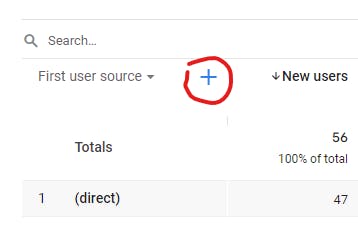Transform Your Analytics Approach With Second Measurement in Google Analytics
By incorporating secondary dimensions into information analysis, a brand-new layer of insights arises, shedding light on detailed user actions and communications. The strategic application of second dimensions holds the crucial to unlocking a treasure chest of very useful information that can change exactly how businesses act and interpret upon their information.
Understanding Additional Measurements in Google Analytics
Additional dimensions in Google Analytics give extra context to key information by enabling customers to analyze metrics across a 2nd measurement, using deeper understandings right into user habits and communications on a website. Secondary Dimension in Google Analytics. While main dimensions offer basic data points such as pageviews, bounce price, and session period, second dimensions use an even more detailed sight by segmenting the primary information better. This segmentation allows individuals to examine metrics in mix with another measurement, such as website traffic resources, demographics, or customer habits
Benefits of Utilizing Additional Measurements
Utilizing secondary dimensions in Google Analytics provides a critical benefit by enhancing the depth of analysis and providing an extra comprehensive understanding of user interactions and behavior on a web site. By integrating additional measurements, experts can get useful insights right into the performance of certain segments or variables within their data. This allows a more comprehensive evaluation of user behavior past surface-level metrics, allowing for a deeper expedition of the variables affecting individual interaction and conversions.
Just How to Execute Secondary Measurements
When integrating secondary measurements in Google Analytics, one important action is to select the pertinent metrics and dimensions to improve the analysis procedure. To implement secondary dimensions successfully, begin by accessing your Google Analytics account and browsing to the record you intend to improve with additional information. When in the report, find the "Secondary Measurement" switch, typically discovered over the data table. Clicking this switch will certainly open up a drop-down menu listing numerous dimensions that can be included to your main measurement for deeper understandings.
After choosing the ideal secondary dimension, such as 'Source/Medium' or 'Gadget Classification,' Google Analytics will certainly present the data in an extra detailed style, enabling you to cross-analyze various facets of customer actions. Remember to try out different mixes of key and secondary dimensions to uncover important patterns and patterns that can notify your advertising and marketing strategies. By carrying out second measurements thoughtfully, you can gain a more comprehensive understanding of your website or app performance and make data-driven choices to maximize your electronic presence.
Analyzing Data With Secondary Measurements
Enhance your information evaluation in Google Analytics by integrating secondary dimensions to delve much deeper right into user actions patterns and maximize your digital marketing strategies effectively - Secondary Dimension in Google Analytics. By including secondary measurements to your main data, you can gain beneficial insights that can help you make notified decisions concerning your site or app efficiency
Analyzing information with additional dimensions permits you to segment your key data better, offering an extra detailed sight of individual communications. Incorporating the main measurement of 'source/medium' with a secondary measurement like 'touchdown page' can expose which particular pages are driving web traffic from various sources. This info can be instrumental in fine-tuning your web content strategy or enhancing your marketing campaign to increase conversions.
Additionally, making use of secondary dimensions enables you to recognize relationships between different metrics, assisting you recognize the impact of various factors on individual habits. Whether it's assessing demographics alongside user interaction metrics or tool groups with conversion click to find out more rates, secondary dimensions equip you to reveal concealed trends and patterns that can lead your advertising and marketing efforts.
Maximizing Efficiency With Additional Dimensions
To enhance the performance of data analysis and decision-making in Google Analytics, incorporating second measurements is vital to optimizing performance metrics and obtaining deeper insights right into individual habits patterns. By using second dimensions, experts basics can dig past surface-level data and discover important connections that may otherwise go unnoticed. This optimization strategy makes it possible for companies to tailor their advertising efforts better, recognize locations for enhancement in site usability, and enhance total user experience.
Second measurements use a more comprehensive sight of customer interactions by providing added context to main data metrics. For instance, pairing the key dimension of 'landing web page' with an additional measurement like 'gadget category' can disclose whether specific devices are most likely to drive involvement on certain landing web pages. This insight can notify responsive style enhancements or targeted advertising approaches to improve performance.

Verdict
To conclude, the integration of second measurements in Google Analytics supplies services with a powerful device to improve their analytics strategy. Secondary Dimension in Google Analytics. By diving deeper into customer habits and communications, marketing experts can discover beneficial insights that can drive efficiency optimization and enhance the general user experience. Leveraging secondary measurements allows for an extra extensive evaluation of data, bring about more educated decision-making and tailored advertising efforts
Additional dimensions in Google Analytics supply added context to main information by allowing individuals to assess metrics across a 2nd measurement, providing much deeper understandings into customer behavior and communications on a website. While main measurements provide essential information factors such website here as pageviews, bounce rate, and session duration, second dimensions provide a more comprehensive sight by segmenting the primary data better.One of the key benefits of making use of second dimensions is the capacity to reveal correlations and patterns that might not be right away noticeable when evaluating information with key dimensions alone.When integrating additional measurements in Google Analytics, one essential step is to select the appropriate metrics and measurements to improve the evaluation procedure. Pairing the key dimension of 'touchdown page' with an additional measurement like 'device group' can reveal whether certain gadgets are extra most likely to drive interaction on specific touchdown pages.